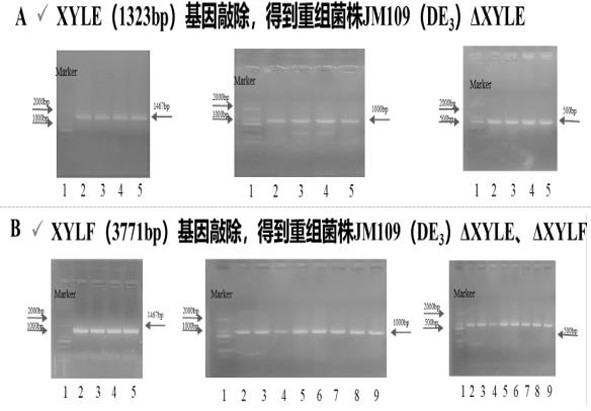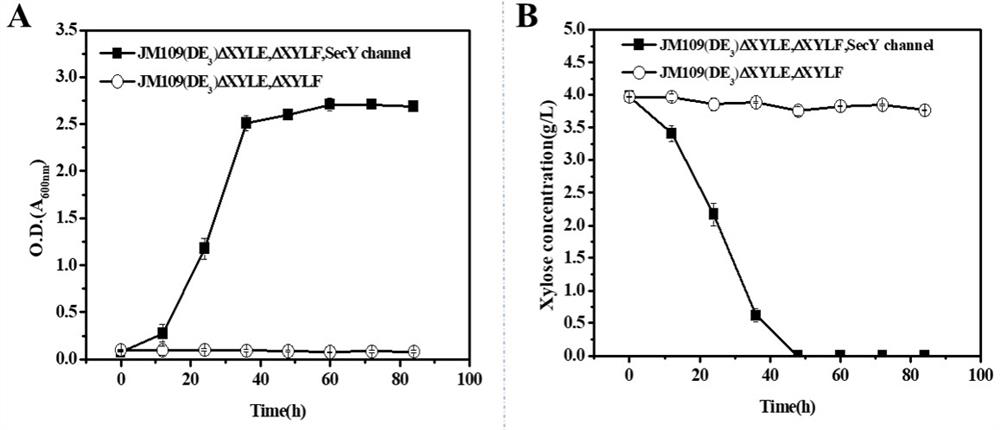Intelligent regulation and control method for carbon metabolism flow of xylitol produced by escherichia coli
A technology of Escherichia coli and xylitol, applied in the field of microbial metabolic engineering, can solve problems such as low xylitol yield and inability to transport xylose into cells
- Summary
- Abstract
- Description
- Claims
- Application Information
AI Technical Summary
Problems solved by technology
Method used
Image
Examples
Embodiment 1
[0029] Knockout in E. coli JM109(DE3) wxya and xylE, Completely remove the xylose transport ability in the strain and limit the metabolism of xylose by the strain. Knockout of Escherichia coli native xylose transporter by λred homologous recombination wxya and xyE , the purpose is to verify the role of SecY non-specific sugar transport channel in genetically engineered strains.
[0030] The specific knockout process includes the following steps:
[0031] Design PCR primers containing homology arm sequences respectively and use the pkD13 plasmid as a template for PCR amplification to obtain a KANA fragment containing homology arms and FRT recognition sites at both ends. Sugar-induced JM109 (DE3) competent cells were cultured at 37°C. Use the genome sequence to design PCR primers to verify that the KANA fragment (its nucleotide sequence is shown in SEQ ID NO.6) was successfully replaced wxya gene and xyE After transfecting the pCP20 plasmid, it is used to specifical...
Embodiment 2
[0034] Example 2 Construction Construction and expression of SecY non-specific sugar transport channel
[0035] Select JM109(DE3)ΔXylF-ΔXylE Escherichia coli as the chassis host, and co-express the double expression plasmid pETDuet-1 and pRSFDuet-1 through the recombinant vector secY(ΔP) , secE , secG and sCVE four genes.
[0036] the above secY(ΔP) The acquisition of genes includes the following methods: using overlapping PCR genetic engineering methods to construct Escherichia coli K family strains secY The mutated gene after the 60-74 amino acids in the gene are replaced by a flexible fragment including four amino acids of GlySerGlySer secY(ΔP) , secY(ΔP) The nucleotide sequence of the gene is shown in SEQ ID NO.1 . secY Gene NCBI Gene ID: 947799. The primers involved in overlapping PCR are as follows:
[0037]
[0038] the above sCVE The acquisition of genes includes the following methods: according to the preference of Escherichia coli encoded amino ac...
Embodiment 3
[0045] Embodiment 3 constructs and expresses the synthetic pathway of xylitol, overexpression wxya Gene
[0046] wxya gene from Candida boidinii , the gene is artificially synthesized after codon optimization, after optimization wxya The nucleotide sequence of the gene is shown in SEQ ID NO.5. Will wxya The gene was ligated into the recombinant vector prsfDuet- secG - sCVE The recombinant vector prsfDuet- secG - sCVE - wxya .
[0047] Transfect the recombinant vector pETDuet- secY (Δp)- secE and prsfDuet- secG - sCVE - cbxR. Successfully overexpressed in E. coli cells wxya After exogenous gene, obtain SecY engineered Escherichia coli, that is, JM109(DE3)ΔXylF-ΔXylE carrying pETDuet- secY (Δp)- secE and prsfDuet- secG - sCVE - wxya . In LB medium (5 g / L yeast powder, 10 g / L peptone, 10 g / L NaCl), it was initially verified whether xylitol could be synthesized. 50 mM xylose was added to the culture medium, and the culture inducer IPTG co...
PUM
 Login to View More
Login to View More Abstract
Description
Claims
Application Information
 Login to View More
Login to View More - R&D
- Intellectual Property
- Life Sciences
- Materials
- Tech Scout
- Unparalleled Data Quality
- Higher Quality Content
- 60% Fewer Hallucinations
Browse by: Latest US Patents, China's latest patents, Technical Efficacy Thesaurus, Application Domain, Technology Topic, Popular Technical Reports.
© 2025 PatSnap. All rights reserved.Legal|Privacy policy|Modern Slavery Act Transparency Statement|Sitemap|About US| Contact US: help@patsnap.com



